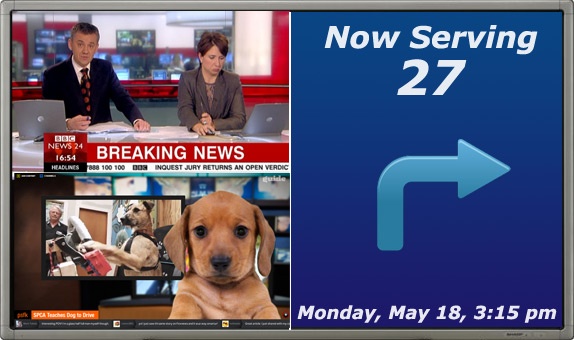Up until a few years ago, queue management systems were synonymous with simple, numeric electronic LED displays. Even today, many queuing solutions use LED technology to display ticket numbers and guide customers to the point of service. Recently however, an increasing number of businesses and organizations are incorporating multimedia displays into their queuing systems.
There are several reasons for this new trend, including the constantly dropping prices of large, clearly readable plasma or LCD screens while the price of similar LED technology remains steady. Multimedia screens are highly flexible and have many uses, thanks to their high resolution, vivid screen colors and unending capacity to stream or play videos, DVDs, TV programming and webcasts.
Additionally, multimedia screens use most standard communication protocols for connecting to a computer system or video source, which allows a wider variety of options when buying equipment. On the other hand, LED displays use an assortment of proprietary protocols, which can limit equipment choices due to possible software compatibility issues.
Variety of Uses
The ability to manage one or more processes from start to finish has tremendous benefits for your business by providing quality assurance as well as service level monitoring, tracking task queues and completion time. As a business, you may want to present a variety of content to your customers at service areas and at points-of-sale to employees or staff. Here are a few examples of how to keep your customers engaged and entertained while in a queue.
- Advertising – Transmitting general messages relating to your brand and business or offering product or services promotions.
- General information – Local or national news programs, weather reports, sports events or other TV programming based on keeping waiting customers interested.
- Business information – Presenting the services your business specializes in, featuring the company’s new business hours, explaining how to fill service order forms or request a professional consultation, and so on.
- Ambient videos – Pleasant travelogues or a variety of scenes of landscapes and nature accompanied by appropriate music clips can make the waiting experience more pleasant.
- Queue Management information – Calling customers forward, displaying directions to the point of service and estimated waiting times.
With multimedia digital sign displays, you can design your own screen layout, so that you can combine these content types in a variety of ways. One of your goals in designing this programming layout should be to feature contents that are important to your business in concert with those that are important to your customers.
For example, consider displaying ads while a “news ticker” is running across the bottom of the screen. This combination draws your customers’ attention to the screen while exposing them to your advertising at the same time. Or, you could integrate your queuing system onto the screen in place of the news ticker. Levels of news interest vary with each customer, but everyone wants to follow the progress of the line or queue in which they’re waiting.
Step Up Your Game with Customer Feedback
In this age of fierce, fast business competition, it’s necessary to make the experience of the customers pleasant and engaging by using a queue management system. But in order to gain that competitive edge, it’s also necessary to get customer feedback so you can optimize on the service that would best increase customer traffic and retention.
Customers want to be heard and they want their opinion to matter. This is a win-win situation, because it will also help you develop ways to improve customer satisfaction. Consider installing a touch screen-based system provisioned with queue management and feedback systems. Such a tool records feedback from customers using on-screen keyboards which can offer and record both open-ended and closed-ended responses. It can also be integrated with queue management system to perform analysis of service, employees and systems in place.
It’s an interactive method of allowing your customers to have their say while demonstrating that you obviously value their opinions enough to use that information to ramp up your customer service. This type of system can also take polls, create reports and share promotional messages and videos with anyone who uses it to submit his or her feedback. Multiple units can be installed in key customer waiting areas so the maximum number of responses can be recorded.
Today, our daily activities assume such a frenetic pace that standing somewhere doing nothing for any length of time seems absurd and annoying. Therefore, it’s imperative to engage your customers so that the time they spend waiting doesn’t seem so agonizingly long and boring, leaving a bad memory in their minds. Queues are a necessary part of life, but by making the queue in your business an experience instead of something to be endured – you can have a positive impact on your customer base and your bottom line.
